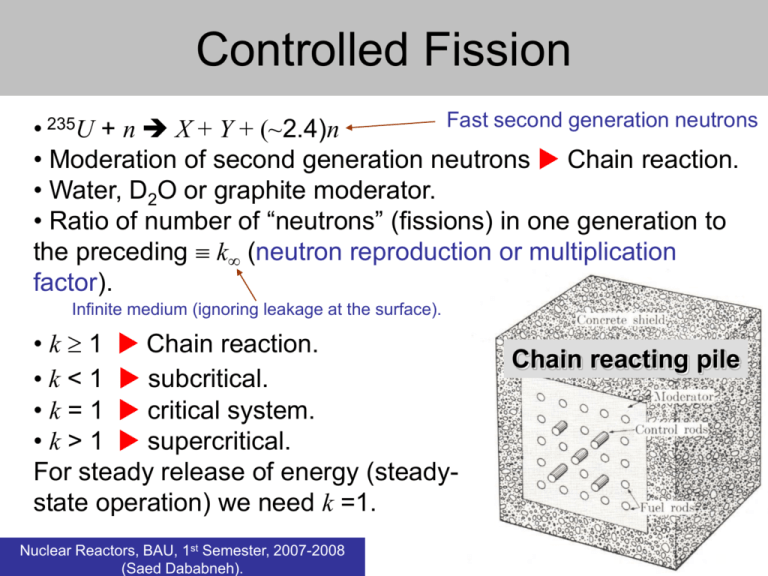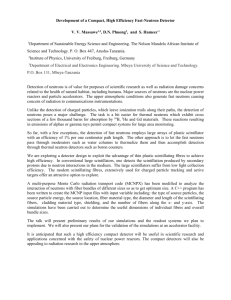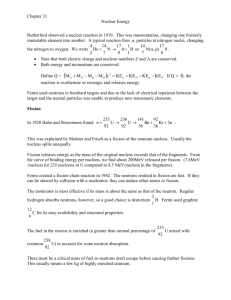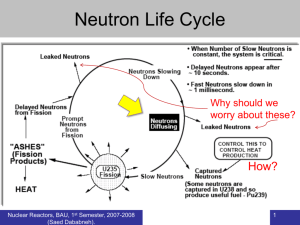Lecture 4. - nuclear@bau
advertisement

Controlled Fission Fast second generation neutrons • 235U + n X + Y + (~2.4)n • Moderation of second generation neutrons Chain reaction. • Water, D2O or graphite moderator. • Ratio of number of “neutrons” (fissions) in one generation to the preceding k (neutron reproduction or multiplication factor). Infinite medium (ignoring leakage at the surface). • k 1 Chain reaction. • k < 1 subcritical. • k = 1 critical system. • k > 1 supercritical. For steady release of energy (steadystate operation) we need k =1. Nuclear Reactors, BAU, 1st Semester, 2007-2008 (Saed Dababneh). Chain reacting pile 1 Controlled Fission • • • • • • Average number of all neutrons released per fission (for thermal neutrons, 0.0253 eV). 233U : 2.492 235U : 2.418 239Pu : 2.871 241Pu : 2.927 Reactor is critical (k = 1): rate of neutrons produced by fission = rate of neutrons absorbed + leaked. Size and composition of the reactor. Controlled Fission 235U thermal cross sections fission 584 b. scattering 9 b. radiative capture 97 b. Probability for a thermal neutron to cause fission on 235U is f 1 f 1 If each fission produces an average of neutrons, then the mean number of fission neutrons produced per thermal neutron = f f a f 1 Nuclear Reactors, BAU, 1st Semester, 2007-2008 (Saed Dababneh). < 3 Controlled Fission • Assume natural uranium: 99.2745% 238U, 0.7200% 235U. Thermal f = 0 b Thermal = 2.75 b 584 b 97 b 235U 4R 2 x y N x x N y y ( x x y y ) N • f / N = (0.992745)(0) + (0.0072)(584) = 4.20 b. • / N = (0.992745)(2.75) + (0.0072)(97) = 3.43 b. Nuclear Reactors, BAU, 1st Semester, 2007-2008 (Saed Dababneh). 238U Doppler effect? 4R 2 Using the experimental elastic scattering data the radius of the nucleus can be estimated. 4 Moderation (to compare x-section) (n,n) (n,) 2H (n,n) 1H (n,) • Resonances? Controlled Fission • Probability for a thermal neutron to cause fission in natural uranium 4.20 4.20 3.43 0.55 • If each fission produces an average of = 2.4 neutrons, then the mean number of fission neutrons produced per thermal neutron = = 2.4 x 0.55 1.3 • This is close to 1. If neutrons are still to be lost, there is a danger of losing criticality. (Heavy water?). • For enriched uranium (235U = 3%) = ????? (> 1.3). (Light water?). • In this case is further from 1 and allowing for more neutrons to be lost while maintaining criticality. Nuclear Reactors, BAU, 1st Semester, 2007-2008 (Saed Dababneh). 6 Controlled Fission HW 11 • Verify 1 a (i) f (i ) i • Comment on the calculation for thermal neutrons and a mixture of fissile and non-fissile materials, giving an example. • Comment for fast neutrons and a mixture of fissionable materials, giving an example. Nuclear Reactors, BAU, 1st Semester, 2007-2008 (Saed Dababneh). 7 Conversion and Breeding Converters: Convert non-thermally-fissionable material to a thermally-fissionable material. U n U 238 23min 239 239 _ Np 2.3d 239 _ Pu f,th = 742 b _ Th n233Th 22 min 233Pa 232 d 27 1st Nuclear Reactors, BAU, Semester, 2007-2008 (Saed Dababneh). _ U 233 f,th = 530 b 8 Conversion and Breeding • If = 2 Conversion and fission. • If > 2 Breeder reactor. • 239Pu: Thermal neutrons ( = 2.1) hard for breeding. Fast neutrons ( = 3) possible breeding fast breeder reactors. After sufficient time of breeding, fissile material can be easily (chemically) separated from fertile material. Compare to separating 235U from 238U. Nuclear Reactors, BAU, 1st Semester, 2007-2008 (Saed Dababneh). 9 Controlled Fission • N thermal neutrons in one generation have produced so far N fast neutrons. • Some of these fast neutrons can cause 238U fission more fast neutrons fast fission factor = (= 1.03 for natural uranium). • Now we have N fast neutrons. • We need to moderate these fast neutrons use graphite for 2 MeV neutrons we need ??? collisions. How many for 1 MeV neutrons? • The neutron will pass through the 10 - 100 eV region during the moderation process. This energy region has many strong 238U capture resonances (up to ????? b) Can not mix uranium and graphite as powders. • In graphite, an average distance of 19 cm is needed for thermalization the resonance escape probability p ( 0.9). Nuclear Reactors, BAU, 1st Semester, 2007-2008 (Saed Dababneh). 10 Controlled Fission • Now we have pN thermal neutrons. • Graphite must not be too large to capture thermal neutrons; when thermalized, neutrons should have reached the fuel. • Graphite thermal cross section = 0.0034 b, but there is a lot of it present. • Capture can also occur in the material encapsulating the fuel elements. • The thermal utilization factor f ( 0.9) gives the fraction of thermal neutrons that are actually available for the fuel. • Now we have fpN thermal neutrons, could be > or < N thus determining the criticality of the reactor. The four-factor formula. k = fp k = fp(1-lfast)(1-lthermal) Nuclear Reactors, BAU, 1st Semester, 2007-2008 (Saed Dababneh). Fractions lost at surface 11 Neutron reproduction factor k = 1.000 x 0.9 Thermal utilization factor “f” x x 0.9 Resonance escape probability ”p” What is: • Migration length? • Critical size? How does the geometry affect the reproduction factor? Nuclear Reactors, BAU, 1st Semester, 2007-2008 (Saed Dababneh). x 1.03 Fast fission factor “” 12





